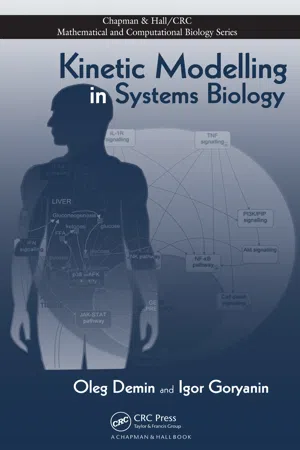
- 360 pages
- English
- PDF
- Available on iOS & Android
Kinetic Modelling in Systems Biology
About This Book
With more and more interest in how components of biological systems interact, it is important to understand the various aspects of systems biology. Kinetic Modelling in Systems Biology focuses on one of the main pillars in the future development of systems biology. It explores both the methods and applications of kinetic modeling in this emerging field.
The book introduces the basic biological cellular network concepts in the context of cellular functioning, explains the main aspects of the Edinburgh Pathway Editor (EPE) software package, and discusses the process of constructing and verifying kinetic models. It presents the features, user interface, and examples of DBSolve as well as the principles of modeling individual enzymes and transporters. The authors describe how to construct kinetic models of intracellular systems on the basis of models of individual enzymes. They also illustrate how to apply the principles of kinetic modeling to collect all available information on the energy metabolism of whole organelles, construct a kinetic model, and predict the response of the organelle to changes in external conditions. The final chapter focuses on applications of kinetic modeling in biotechnology and biomedicine.
Encouraging readers to think about future challenges, this book will help them understand the kinetic modeling approach and how to apply it to solve real-life problems.
Downloadable Resources Features
Extensively used throughout the text for pathway visualization and illustration, the EPE software is available on the accompanying downloadable resources. The downloadable resources also include pathway diagrams in several graphical formats, DBSolve installation with examples, and all models from the book with dynamic visualization of simulation results, allowing readers to perform in silico simulations and use the models as templates for further applications.
Frequently asked questions
Information
Table of contents
- Front cover
- Table of Contents
- About the Authors
- Introduction
- Chapter 1. Systems Biology, Biological Knowledge and Kinetic Modelling
- Chapter 2. Cellular Networks Reconstruction and Static Modelling
- Chapter 3. Edinburgh Pathway Editor
- Chapter 4. Construction and Verification of Kinetic Models
- Chapter 5. Introduction to DBSolve
- Chapter 6. Enzyme Kinetics Modelling
- Chapter 7. Kinetic Models of Biochemical Pathways
- Chapter 8. Modelling of Mitochondrial Energy Metabolism
- Chapter 9. Application of the Kinetic Modelling Apporach to Problems in Biotechnology and Biomedicine
- Conclusion and Discussion
- References
- Index
- Back cover